The AMD Llano Notebook Review: Competing in the Mobile Market
by Jarred Walton & Anand Lal Shimpi on June 14, 2011 12:01 AM ESTApplications, Round Two: Treading Water
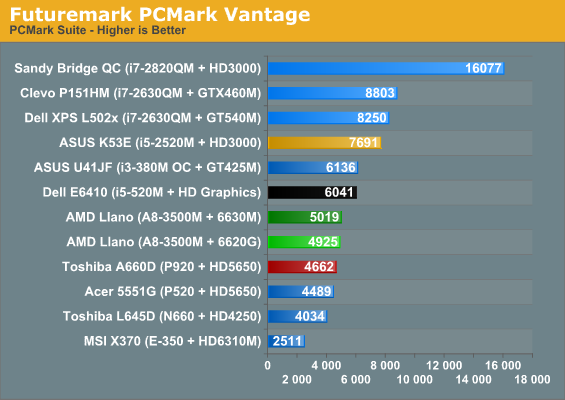
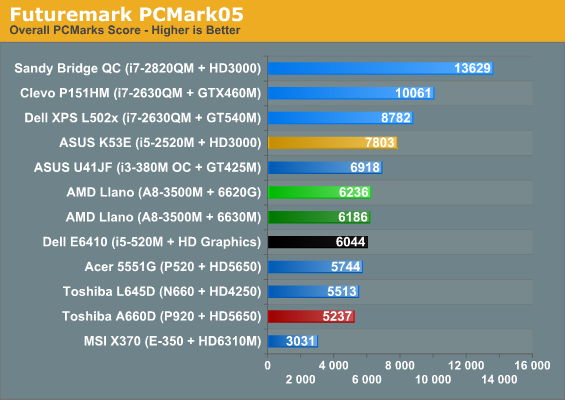
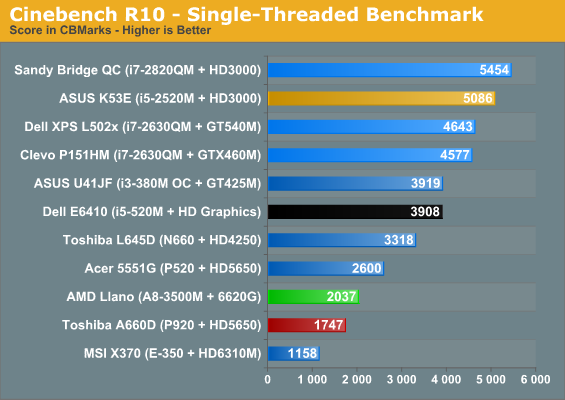

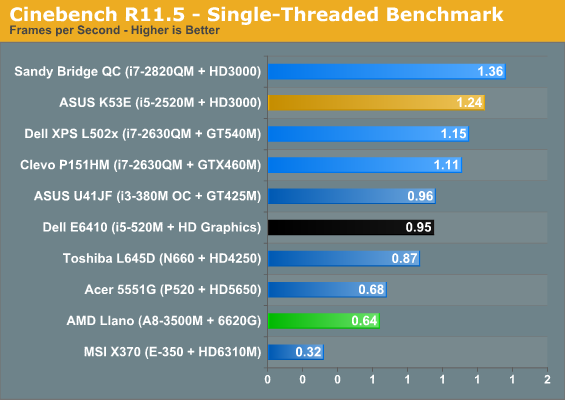
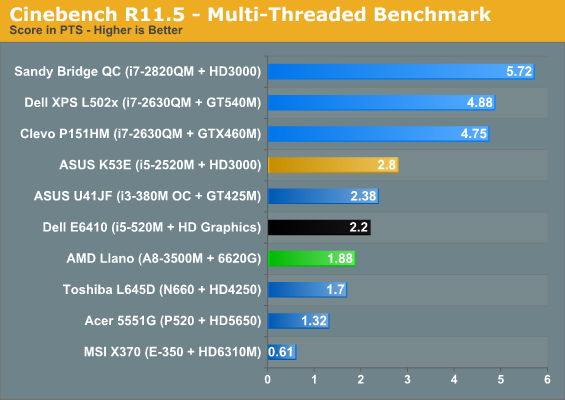
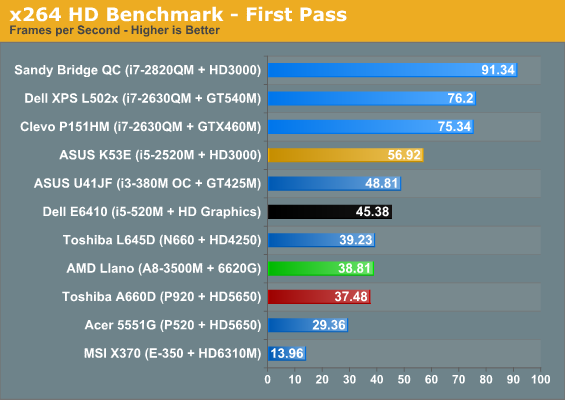
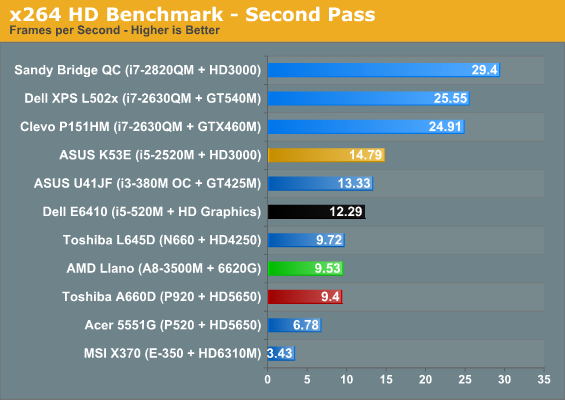
This time we have a more interesting competitor to look at: the Toshiba A660D. AMD says Turbo Core works at speeds of up to 2.4GHz on the A8-3500M, but we have no way of monitoring the actual CPU clocks right now. (CPU-Z if you’re wondering shows a constant 1.5GHz, but AMD says that utility doesn’t currently detect the proper clocks.) When we compare performance results between the Llano notebook and the A660D, we definitely see some differences in performance. Some of that may come from the added L2 cache and other architectural tweaks, but Cinebench R10 in particular shows a healthy 17% performance increase, even with a base clock that’s 7% lower. In the multi-threaded Cinebench result, the lead drops to 10%, which correlates well with how we’d expect Turbo Core to work. PCMark Vantage is still heavily influenced by the storage subsystem, and the storage score of 2950 on the A660D versus 3791 on the Llano suggests the Toshiba HDD is a significant bottleneck.
Looking at other laptops and tests where we’re looking purely at CPU performance, suddenly Llano starts to struggle. The Arrandale i5-520M offers 92% higher single-threaded performance in Cinebench R10 and 48% better single-threaded performance in R11.5; multi-threaded performance also goes to Arrandale, with a 23% lead in R10 and 17% lead in R11.5. x264 also gives Arrandale a decent lead, with i5-520M 17% faster in the first pass and 29% faster in the more intense second pass. The overclocked i3-380M in ASUS’ U41JF tells a similar tale—and both of these laptops are running processors from early last year. When we shift to Sandy Bridge, even without looking at the quad-core parts AMD’s CPU performance is tenuous. The i5-2520M is anywhere from 50 to 150 percent faster depending on which test we look at; even if we toss out the older Cinebench R10 single-threaded result of 150%, R11.5 given the 2520M a 94% lead. In general, then, a moderate dual-core Sandy Bridge i5-series processor looks to be at least 30% faster, so quad-core Llano really only competes with Core i3 and its lower, non-Turbo clocks.
None of the results here are particularly surprising; K10.5 even at 32nm is still largely the same performance. AMD has focused this round up upgrades more on reducing power consumption rather than increasing performance, and that’s a perfectly reasonable approach for a mobile CPU. Most of us probably aren’t doing 3D rendering, CAD/CAM, or unassisted video transcoding on our laptops anyway. It would still be great to see AMD offer up an equivalent to Intel’s Quick Sync; they have the better GPU architecture, but a dedicated decoder like Quick Sync can clearly pay dividends. Outside of that one deficit the reality is that Llano is still plenty fast. Slapping an SSD into Llano will make more of a difference than upgrading an HDD-based Llano laptop to Core i5, so if you’re looking for an inexpensive laptop that can do everything most users need, Llano is very appealing.










177 Comments
View All Comments
ET - Wednesday, June 15, 2011 - link
It may be impossible to know the exact speed the cores run, but it would be interesting to run a test to get some relative numbers.You can run a single threaded CPU bound program such as SuperPI, then run it again with the other three cores at 100% (for example by having another three instances of SuperPI running). Do this on AC and battery, and it might generate some interesting numbers. At the very least we'll be able to tell whether the 1.5GHz -> 2.4GHz ratio looks right.
ET - Wednesday, June 15, 2011 - link
By the way, I just read Tom's Hardware review, which was unique in that it compared to a Phenom II X4 running at 1.5GHz and 2.4GHz. It looked from these benchmarks like the A8-3500M is always performing around the 1.5GHz level of the Phenom II X4 (sometimes it's a little faster, sometimes a little slower), which suggests that Turbo Core doesn't really kick in.i_am_the_avenger - Wednesday, June 15, 2011 - link
Maybe this will cheer the AMD Fans a bitThis article did not mention some nifty features the APUs have (or maybe it did I did not read it line by line)...................................
Watch the video below from engadget:
http://www.engadget.com/2011/06/13/amds-fusion-a-s...
It shows how these APUs can smooth out shaking videos real time, even while streaming from Youtube! and it does a very good job.
Another feature is how it en-chances videos (colour etc.)
This improves general user PC experience.......... something very desirable
The video also shows how AMD wants to target general users and not work enthusiasts
Another video shows comparison between the i7-2630QM and A8-3500M while multitasking video related applications.
http://www.engadget.com/2011/03/01/amd-compares-up...
---Interesting to note that the APU Gradually increased its power consumption while i7 was like bursting to and fro, something the way turbo core acts maybe-----
I think it is work vs general performance,
Intel's great for work, when you need to finish tasks and it needs to be done quickly,
while AMD APUs give you a good over all pc and multimedia performance - you watch videos, play games, so what if the zip file extracts a minute late and the fGPU performance is great....
You may buy a i7 SNB with discreate GPU but that has a battery life hit (for same battery capacity) and also extra heat generation which requires more fans, also the extra weight..
Please don't start judging me or something....
I am getting confused myself, while intel looks great in every way except stock gaming and battery life(not that bad)... I think I don't need that much power, even if I work - my work isn't so CPU oriented that an i7 would matter, a 30 second task finishes in 20 ok but it does not matter to me..... but improved video and battery seems more useful to me
I don't think that all of us have to tax our CPUs to full potential -- a few have to, not considering them -- so even if Intel have faster processors for many it does not affect them as much.
psychobriggsy - Wednesday, June 15, 2011 - link
For all your moaning about not getting Asymmetric CrossFire to work, you didn't read the reviewers guide that says it only works in DX10 and DX11 mode, not DX9. So your Dirt2 benches for example clearly state DX9 for this test. I don't know about the other titles on that page - you say 5 of the others are DX9 titles. Do these titles have DX10 modes of operation - if so, USE THEM.Otherwise it just looks like you are trying to get the best results for the Intel Integrated Graphics.
Just put "0 - Unsupported" for DX11 tests by HD3000 like other sites have done.
ET - Wednesday, June 15, 2011 - link
The article said:"AMD told us in an email on Monday (after all of our testing was already complete) that the current ACF implementation on our test notebook and with the test drivers only works on DX10/11 games. It's not clear if this will be the intention for future ACF enabled laptops or if this is specific to our review sample. Even at our "High" settings, five of our ten titles are DX9 games (DiRT 2, L4D2, Mafia II, Mass Effect 2, and StarCraft II--lots of twos in there, I know!), so they shouldn't show any improvement...and they don't. Actually, the five DX9 games even show reduced performance relative to the dGPU, so not only does ACF not help but it hinders. That's the bad news. The only good news is that the other half of the games show moderate performance increases over the dGPU."
I agree that at least in the case of DiRT 2 that's blatantly false, since that game was one of the first to use DX11, and was given with many Radeon 58x0 cards for this reason.
JarredWalton - Friday, June 17, 2011 - link
DiRT 2 supports DX11, but it's only DX9 or DX11. We chose to standardize on DX9 for our Low/Med/High settings -- and actually, DX11 runs slower at the High settings than DX9 does (though perhaps it looks slightly better). Anyway, we do test DiRT 2 with DX11 for our "Ultra" settings, but Llano isn't fast enough to handle 1080p with 4xAA and DX11. So to be clear, I'm not saying DiRT 2 isn't DX11; I'm saying that the settings we standardized on over a year ago are not DX11.jitttaaa - Wednesday, June 15, 2011 - link
How is the notebook llano performing as good, if not better than the desktop llano?ET - Wednesday, June 15, 2011 - link
At least as far as CPU power is concerned, the desktop part is obviously faster. The benchmarks are mostly not compatible so it's hard to judge, but in Cinebench R10 the mobile Llano gets 2037 while the desktop gets 3390. I agree that for graphics it looks like the desktop part is performing worse in games, which is strange considering the GPU is working at a faster speed.Only explanation I can think of is that the faster CPU is taking too much memory bandwidth, but it doesn't make much sense since it's been said that the GPU gets priority. It's definitely something that's worth checking out with AMD.
ionave - Thursday, June 16, 2011 - link
http://www.anandtech.com/show/4448/amd-llano-deskt...On average the A8-3850 is 58% faster than the Core i5 2500K.
Boom. Delivered. You think its slow? It really isn't. The A8-3850 has about the performance of a DESKTOP i3. If you think that is bad performance, then you don't know what you are talking about. The battery life is amazing for having that kind of performance in a laptop. I'm sorry, but it totally destroys i7 and i5 platforms because of the sheer performance in that amazing battery life.
JarredWalton - Friday, June 17, 2011 - link
Let me correct that for you:On average, the A8-3850 fGPU (6550D) is 58% faster than the Core i5-2500K's HD 3000 IGP, in games running at low quality settings. It is also 29% faster than the i5-2500K with a discrete HD 5450, which is a $25 graphics card. On the other hand, the i5-2500K with an HD 5570 (a $50 GPU) is on average 66% faster than the A8-3850.
Boom. Delivered. You think that's fast? It really isn't. The 6550D has about the performance of a $35 desktop GPU. If you think that is good performance, then you don't know what you are talking about.
At least Llano is decent for laptops, but for $650 you can already get i3-2310M with a GT 520M and Optimus. Let me spell it out for you: better performance on the CPU, similar or better performance on the GPU, and a price online that's already $50 below the suggested target of the A8-3500M. Realistically, A8-3500M will need to sell for $600 to be viable, A6 for $500, and A4 for $450 or less.